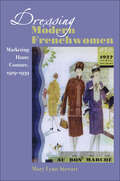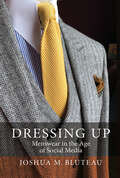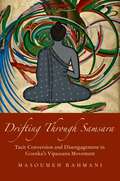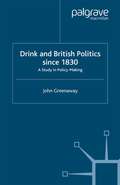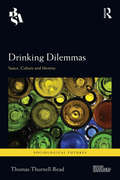- Table View
- List View
Dressing Modern Frenchwomen: Marketing Haute Couture, 1919–1939
by Mary Lynn StewartAt a glance, high fashion and feminism seem unlikely partners. Between the First and Second World Wars, however, these forces combined femininity and modernity to create the new, modern French woman. In this engaging study, Mary Lynn Stewart reveals the fashion industry as an integral part of women's transition into modernity. Analyzing what female columnists in fashion magazines and popular women novelists wrote about the "new silhouette," Stewart shows how bourgeois women feminized the more severe, masculine images that elite designers promoted to create a hybrid form of modern that both emancipated women and celebrated their femininity. She delves into the intricacies of marketing the new clothes and the new image to middle-class women and examines the nuts and bolts of a changing industry—including textile production, relationships between suppliers and department stores, and privacy and intellectual property issues surrounding ready-to-wear couture designs. Dressing Modern Frenchwomen draws from thousands of magazine covers, advertisements, fashion columns, and features to uncover and untangle the fascinating relationships among the fashion industry, the development of modern marketing techniques, and the evolution of the modern woman as active, mobile, and liberated.
Dressing Modern Frenchwomen: Marketing Haute Couture, 1919–1939
by Mary Lynn StewartAt a glance, high fashion and feminism seem unlikely partners. Between the First and Second World Wars, however, these forces combined femininity and modernity to create the new, modern French woman. In this engaging study, Mary Lynn Stewart reveals the fashion industry as an integral part of women's transition into modernity. Analyzing what female columnists in fashion magazines and popular women novelists wrote about the "new silhouette," Stewart shows how bourgeois women feminized the more severe, masculine images that elite designers promoted to create a hybrid form of modern that both emancipated women and celebrated their femininity. She delves into the intricacies of marketing the new clothes and the new image to middle-class women and examines the nuts and bolts of a changing industry—including textile production, relationships between suppliers and department stores, and privacy and intellectual property issues surrounding ready-to-wear couture designs. Dressing Modern Frenchwomen draws from thousands of magazine covers, advertisements, fashion columns, and features to uncover and untangle the fascinating relationships among the fashion industry, the development of modern marketing techniques, and the evolution of the modern woman as active, mobile, and liberated.
Dressing Up: Menswear in the Age of Social Media
by Joshua M. BluteauWhat does men’s fashion say about contemporary masculinity? How do these notions operate in an increasingly digitized world? To answer these questions, author Joshua M. Bluteau combines theoretical analysis with vibrant narrative, exploring men’s fashion in the online world of social media as well as the offline worlds of retail, production, and the catwalk. Is it time to reassess notions of masculinity? How do we construct ourselves in the online world, and what are the dangers of doing so? From the ateliers of London to the digital landscape of Instagram, Dressing Up re-examines the ways men dress, and the ways men post.
Dressing Up: Menswear in the Age of Social Media
by Joshua M. BluteauWhat does men’s fashion say about contemporary masculinity? How do these notions operate in an increasingly digitized world? To answer these questions, author Joshua M. Bluteau combines theoretical analysis with vibrant narrative, exploring men’s fashion in the online world of social media as well as the offline worlds of retail, production, and the catwalk. Is it time to reassess notions of masculinity? How do we construct ourselves in the online world, and what are the dangers of doing so? From the ateliers of London to the digital landscape of Instagram, Dressing Up re-examines the ways men dress, and the ways men post.
Dressing Up: Menswear in the Age of Social Media
by Joshua M. BluteauWhat does men’s fashion say about contemporary masculinity? How do these notions operate in an increasingly digitized world? To answer these questions, author Joshua M. Bluteau combines theoretical analysis with vibrant narrative, exploring men’s fashion in the online world of social media as well as the offline worlds of retail, production, and the catwalk. Is it time to reassess notions of masculinity? How do we construct ourselves in the online world, and what are the dangers of doing so? From the ateliers of London to the digital landscape of Instagram, Dressing Up re-examines the ways men dress, and the ways men post.
Dressing Up: Menswear in the Age of Social Media
by Joshua M. BluteauWhat does men’s fashion say about contemporary masculinity? How do these notions operate in an increasingly digitized world? To answer these questions, author Joshua M. Bluteau combines theoretical analysis with vibrant narrative, exploring men’s fashion in the online world of social media as well as the offline worlds of retail, production, and the catwalk. Is it time to reassess notions of masculinity? How do we construct ourselves in the online world, and what are the dangers of doing so? From the ateliers of London to the digital landscape of Instagram, Dressing Up re-examines the ways men dress, and the ways men post.
The Dreyfus Affair: The Story of the Most Infamous Miscarriage of Justice in French History
by Piers Paul ReadIntelligent, ambitious and a rising star in the French artillery, Captain Alfred Dreyfus appeared to have everything: family, money, and the prospect of a post on the General Staff. But his rapid rise had also made him enemies - many of them aristocratic officers in the army's High Command who resented him because he was middle-class, meritocratic and a Jew.In October 1894, the torn fragments of an unsigned memo containing military secrets were retrieved by a cleaning lady from the waste paper basket of Colonel Maximilien von Schwartzkoppen of the German embassy in Paris. When French intelligence discovered they harboured a spy in their midst, Captain Dreyfus, on slender evidence, was charged with selling military secrets to the Germans, found guilty of treason by unanimous verdict and sentenced to life imprisonment on the notorious Devil's Island.The fight to free the wrongfully convicted Dreyfus - over twelve long years, through many trials - is a story rife with heroes and villains, courage and cowardice, dissimulation and deceit. One of the most infamous miscarriages of justice in history, the Dreyfus affair divided France, stunned the world and unleashed violent hatreds and anti-Semitic passions which offered a foretaste of what was to play out in the long, bloody twentieth century to come. Today, amid charged debates over national and religious identity across the globe, its lessons throw into sharp relief the conflicts of the present. In the hands of historian, biographer and prize-winning novelist Piers Paul Read, this masterful epic of the struggle between a minority seeking justice and a military establishment determined to save face comes dramatically alive for a new generation.
The Dreyfus Affair And The Crisis Of French Manhood (PDF)
by Christopher ForthIn 1894, French army captain Alfred Dreyfus, an Alsatian Jew, was wrongly accused of passing military secrets to the Germans. The ensuing scandal has often been studied for what it reveals about French anti-Semitism and tensions between republicanism and conservatism under the Third Republic. But because treason was considered a cowardly-and therefore effeminate-act, Dreyfus also embodied, for many, the danger of effeminate men masquerading in military uniform. In The Dreyfus Affair and the Crisis of French Manhood historian Christopher E. Forth shows how the rhetoric and images used during the Dreyfus Affair reflected French anxieties about masculinity and modernity, and also facilitated ongoing debates about the state of French manhood through the First World War. Forth first considers the broad gender issues that faced the French at the time of the Dreyfus trial. He examines contemporary newspaper accounts as critiques of the masculine credentials of Jewish men and shows how members of the Jewish press answered allegations of their own cowardice and effeminacy. By situating the figure of the "intellectual" within the gender anxieties of the time, he shows how Dreyfus's supporters defensively tried to affirm their masculinity by distancing themselves from "cowardly" Jews, "hysterical" crowds, and threatening women. This book pays special attention to how the Dreyfus Affair engaged with changing ideals of the male body. Taking as a metaphor the portly body of Dreyfus's most prominent defender, novelist #65533;mile Zola, Forth explores how an emerging emphasis on diet and exercise allowed supporters to celebrate Zola's "heroic" weight loss. Finally, he examines the relation of the Dreyfus Affair to the "culture of force" that marked French society during the prewar years, thus accounting for the rise of the youthful athlete as a more compelling manly ideal than the bookish and sedentary intellectual.
The Drift: Affect, Adaptation And New Perspectives On Fidelity
by John HodgkinsThe Drift: Affect, Adaptation, and New Perspectives on Fidelity offers a new perspective on the complex interrelations between literature and cinema. It does so by articulating an 'affective turn' for adaptation studies, a field whose traditional focus has been the critical castigation of film adaptations of canonical plays or novels. Drawing on theorists such as Gilles Deleuze, Brian Massumi, and Marco Abel,the author is able to re-conceive literary and cinematic works as textual engines generating and circulating affect, and the adaptive process as a drifting of those affective intensities from one medium to another. By conceptualizing adaptation in this manner, the work steers clear of the chimerical notion of 'fidelity' (to character, to theme, to narrative) which has anchored so many analyses of adaptive texts over the years-and the reproving language that inevitably attends it-in favor of more productive avenues of investigation: What affective work are certain literary and filmic texts performing? What can this tell us, more broadly, about the underexplored affective dimensions of literature and cinema, and the dialogic interactions between them? The Drift addresses such questions through close, careful readings which put a variety of realist, modernist, and postmodernist works into conversation with each other, among them the fiction of John Dos Passos, Don DeLillo, and Susanna Moore, the films of Dziga Vertov and Sergei Eisenstein, as well as recent cinematic adaptations by Jane Campion and Charles Burnett. This methodological approach, helps to elevate adaptation studies into a discourse that speaks more directly and pertinently to our fluid, hypertextual era.
The Drift: Affect, Adaptation, And New Perspectives On Fidelity
by John HodgkinsThe Drift: Affect, Adaptation, and New Perspectives on Fidelity offers a new perspective on the complex interrelations between literature and cinema. It does so by articulating an 'affective turn' for adaptation studies, a field whose traditional focus has been the critical castigation of film adaptations of canonical plays or novels. Drawing on theorists such as Gilles Deleuze, Brian Massumi, and Marco Abel,the author is able to re-conceive literary and cinematic works as textual engines generating and circulating affect, and the adaptive process as a drifting of those affective intensities from one medium to another. By conceptualizing adaptation in this manner, the work steers clear of the chimerical notion of 'fidelity' (to character, to theme, to narrative) which has anchored so many analyses of adaptive texts over the years-and the reproving language that inevitably attends it-in favor of more productive avenues of investigation: What affective work are certain literary and filmic texts performing? What can this tell us, more broadly, about the underexplored affective dimensions of literature and cinema, and the dialogic interactions between them? The Drift addresses such questions through close, careful readings which put a variety of realist, modernist, and postmodernist works into conversation with each other, among them the fiction of John Dos Passos, Don DeLillo, and Susanna Moore, the films of Dziga Vertov and Sergei Eisenstein, as well as recent cinematic adaptations by Jane Campion and Charles Burnett. This methodological approach, helps to elevate adaptation studies into a discourse that speaks more directly and pertinently to our fluid, hypertextual era.
Drifting through Samsara: Tacit Conversion and Disengagement in Goenka's Vipassana Movement (AAR Academy Series)
by Masoumeh RahmaniIn Drifting Through Samsara, Masoumeh Rahmani provides a fieldwork-based study of Goenka's Vipassana meditation movement in New Zealand. This group is distinguished by its refusal to identify as Buddhist and by a rich rhetorical repertoire for repackaging Theravada Buddhist teachings in pseudo-scientific and secular language. Drawing from qualitative research, the book examines the way the movement's discourse shapes unique processes and narratives of conversion and disengagement. Rahmani argues that conversion to this movement is tacit and paradoxically results in the members' rejection of religious labels and categories including conversion. Tracing the linguistic changes associated with the process of conversion and increased commitment, she outlines three main disengagement pathways: (1) pragmatic leaving, (2) disaffiliation, and (3) deconversion. Pragmatic leavers are individuals who were disengaged prior to developing a commitment. Rahmani argues that the language of these leavers is characterised by pragmatisms, dualistic discourse, and ambivalence, and their post-disengagement involves an active gravitation towards practices with easily accomplished goals. Disaffiliates and deconverts are individuals who disengaged after years of intense commitment to the movement. One of the distinguishing features of disaffiliation narratives is self-doubt resulting from the movement's ambiguous discourse regarding progress. For these people post-disengagement often involves the retrospective adoption of Buddhist identity. Rahmani finds that as a consequence of its linguistic strategies, deconversion is a rare exit pattern from this movement. In general, however, the themes and characteristics of both disaffiliation and deconversion fit the contours of exit from other traditions, even though conversion was tacit in the first place. The book thus questions the normative participant recruitment approach in conversion studies and argues that a simple reliance on the informants' identification with or rejection of religious labels fails to encompass the tonalities of conversion in the contemporary spiritual landscape.
Drifting through Samsara: Tacit Conversion and Disengagement in Goenka's Vipassana Movement (AAR Academy Series)
by Masoumeh RahmaniIn Drifting Through Samsara, Masoumeh Rahmani provides a fieldwork-based study of Goenka's Vipassana meditation movement in New Zealand. This group is distinguished by its refusal to identify as Buddhist and by a rich rhetorical repertoire for repackaging Theravada Buddhist teachings in pseudo-scientific and secular language. Drawing from qualitative research, the book examines the way the movement's discourse shapes unique processes and narratives of conversion and disengagement. Rahmani argues that conversion to this movement is tacit and paradoxically results in the members' rejection of religious labels and categories including conversion. Tracing the linguistic changes associated with the process of conversion and increased commitment, she outlines three main disengagement pathways: (1) pragmatic leaving, (2) disaffiliation, and (3) deconversion. Pragmatic leavers are individuals who were disengaged prior to developing a commitment. Rahmani argues that the language of these leavers is characterised by pragmatisms, dualistic discourse, and ambivalence, and their post-disengagement involves an active gravitation towards practices with easily accomplished goals. Disaffiliates and deconverts are individuals who disengaged after years of intense commitment to the movement. One of the distinguishing features of disaffiliation narratives is self-doubt resulting from the movement's ambiguous discourse regarding progress. For these people post-disengagement often involves the retrospective adoption of Buddhist identity. Rahmani finds that as a consequence of its linguistic strategies, deconversion is a rare exit pattern from this movement. In general, however, the themes and characteristics of both disaffiliation and deconversion fit the contours of exit from other traditions, even though conversion was tacit in the first place. The book thus questions the normative participant recruitment approach in conversion studies and argues that a simple reliance on the informants' identification with or rejection of religious labels fails to encompass the tonalities of conversion in the contemporary spiritual landscape.
Drink and British Politics Since 1830: A Study in Policy Making
by J. GreenawayThe issue of alcohol has never been far from British politics. Initially, governments needed to control its sale for public order reasons and because it was a major source of revenue. Then in Victorian times a powerful temperance movement arose which sought to prohibit or severely curb the 'Demon Drink'. This in turn aroused the hostility of the 'Trade' and the issue became one of fierce electoral politics. After 1890 drink was interpreted more as a social reform question and then in the First World War, after a major moral panic, far-reaching measures of direct state control were imposed in the interests of national efficiency. Later in the Twentieth century alcohol use came to be seen as an aspect of leisure and town planning and, more recently, as a health issue. Drawing upon a wide range of primary sources, John Greenaway uses the complex politics of the issue to shed light upon the changing political system and to test various theories of the policymaking process. Both historians and political scientists will be interested in this study.
Drink and Culture in Nineteenth-century Ireland: The Alcohol Trade and the Politics of the Irish Public House (International Library Of Historical Studies)
by Bradley KadelThe vibrant Irish public house of the nineteenth century hosted broad networks of social power, enabling publicans and patrons to disseminate tremendous influence across Ireland and beyond. During the period, affluent publicans coalesced into one of the most powerful and sophisticated forces in Irish parliamentary politics. Among the leading figures of public life, they commanded an unmatched economic route to middle-class prosperity, inserted themselves into the centre of crucial legislative debates, and took part in fomenting the issues of class, gender, and national identity which continue to be contested today. From the other side of the bar, regular patrons relied on this social institution to construct, manage and spread their various social and political causes. From Daniel O'Connell to the Guinness dynasty, from the Acts of Union to the Great Famine, and from Christmas boxes to Fenianism; Bradley Kadel offers a first and much-needed scholarly examination of the 'incendiary politics of the pub' in nineteenth-century Ireland.
Drink Beer, Think Beer: Getting To The Bottom Of Every Pint
by John HollFrom an award-winning journalist and beer expert, a thoughtful and witty guide to understanding and enjoying beer Right here, right now is the best time in the history of mankind to be a beer drinker. America now has more breweries than at any time since prohibition, and globally, beer culture is thriving and constantly innovating. Drinkers can order beer brewed with local yeast or infused with moondust. However, beer drinkers are also faced with uneven quality and misinformation about flavors. And the industry itself is suffering from growing pains, beset by problems such as unequal access to taps, skewed pricing, and sexism. Drawing on history, economics, and interviews with industry insiders, John Holl provides a complete guide to beer today, allowing listeners to think critically about the best beverage in the world. Full of entertaining anecdotes and surprising opinions, Drink Beer, Think Beer is a must-listen for beer lovers, from casual enthusiasts to die-hard hop heads.
Drink Like a Woman: Shake. Stir. Conquer. Repeat.
by Jeanette HurtCocktail marketers and male bartenders like to tell women what we want to drink-and it’s usually fruity, frilly, fancy, and pink. In Drink Like a Woman, Jeanette Hurt shakes up barroom expectations, stirs up some new ideas, and pours a lively collection of feminist cocktails that are just as varied, flavorful, and strong as women are. Sharing basic techniques, cocktail classics, hangover cures, drinking games, and more, this spirited guide takes the misogyny out of mixology by offering fun and functional tips for the at-home barista who doesn’t need a man to mix it up. She also exposes the surprisingly sexist history of cocktail culture, and offers more than 50 recipes, crafted by top women bartenders around the country, including: Anarchy AmarettoBloody Mary RichardsNelly Bly-TaiThe LBD (The Little Black Dress)Ruth’s Pink TabooWoManhattanZeldatiniThe Suffragette SourRide, Sally RideCurie Royale With feisty illustrations and original recipes that call for a generous splash of female empowerment, Drink Like a Woman is sure to subvert the patriarchy, one drink at a time.
Drink Spiking and Predatory Drugging: A Modern History
by Pamela DonovanThis book analyses common perceptions about drink-spiking, a pervasive fear for many and sometimes a troubling reality. Ideas about spiked drinks have shaped the way we think about drugs, alcohol, criminal law, risk, nightspots, and socializing for over one hundred and fifty years, since the rise of modern anaesthesia and synthetic 'pharma-ubiquity'. The book offers a wide-ranging look at the constantly shifting cultural and gender politics of 'psycho-chemical treachery'.It provides rich case histories, assesses evolving scientific knowledge, and analyses the influence of social forces as disparate as Temperance and the acid enthusiasts of the 1960s. Drawing on interdisciplinary research, the book will be of great interest to upper-level students and scholars of criminal law, forensic science, public health, and social movements.
Drinking: Anthropological Approaches (Anthropology of Food & Nutrition #4)
by Igor De GarineOver the last decades quite a few studies have been devoted to drinking. Most of these were concerned with alcohol and written by social anthropologists. This book presents multidisciplinary aspects of the ingestion of liquids at large, addressing many of the overt and covert meanings of drinking: from satisfying biological needs to communicating with humans and the hereafter, attempting to reach a differential emotional state or seeking good health and longevity through the ingestion of appropriate beverages. It includes papers from both biological and social scientists and covers a fair range of societies from rural and urban environments, and in continents and countries ranging from Europe, Africa, and Latin America to Malaysia and the Pacific.
Drinking and Casualties: Accidents, Poisonings and Violence in an International Perspective
by Norman GiesbrechtFirst published in 1989. Routledge is an imprint of Taylor & Francis, an informa company.
Drinking and Casualties: Accidents, Poisonings and Violence in an International Perspective
by Norman Giesbrecht René González Marcus Grant Esa Österberg Robin Room Irving Rootman Leland TowleFirst published in 1989. Routledge is an imprint of Taylor & Francis, an informa company.
Drinking Arak Off an Ayatollah's Beard: A Journey Through the Inside-Out Worlds of Iran and Afghanistan
by Nicholas JubberAn engrossing blend of travel writing and history, Drinking Arak off an Ayatollah&’s Beard traces one man&’s adventure-filled journey through today&’s Iran, Afghanistan, and Central Asia, and describes his remarkable attempt to make sense of the present by delving into the past. Setting out to gain insight into the lives of Iranians and Afghans today, Nicholas Jubber is surprised to uncover the legacy of a vibrant pre-Islamic Persian culture that has endured even in times of the most fanatic religious fundamentalism. Everywhere—from underground dance parties to religious shrines to opium dens—he finds powerful and unbreakable connections to a time when both Iran and Afghanistan were part of the same mighty empire, when the flame of Persian culture lit up the world. Whether through his encounters with poets and cab drivers or run-ins with &“pleasure daughters&” and mujahideen, again and again Jubber is drawn back to the eleventh-century Persian epic, the Shahnameh (&“Book of Kings&”). The poem becomes not only his window into the region&’s past, but also his link to its tumultuous present, and through it Jubber gains access to an Iran and Afghanistan seldom revealed or depicted: inside-out worlds in which he has tea with a warlord, is taught how to walk like an Afghan, and even discovers, on a night full of bootleg alcohol and dancing, what it means to drink arak off an Ayatollah&’s beard.
Drinking Diaries: Women Serve Their Stories Straight Up
by Caren Osten Gerszberg Leah Odze EpsteinWhether you drink it or not, alcohol is likely a potent part of your life: our culture is saturated in it. Ask any woman you know to tell you a drinking story, and she’ll come up with one-in fact, she may even come up with five. With friends and with coworkers, at date night and at ladies' night, and on special occasions ranging from Valentine’s Day to the Super Bowl, we encounter alcohol-yet when it comes to discussing the nature of our relationship with drinking, few of us do so honestly and openly.In Drinking Diaries, editors Leah Odze Epstein and Caren Osten Gerszberg take women's drinking stories out of the closet and into the light. Whether it’s shame, sober sex, and relapsing, or college drinking, bonding, and comparing the benefits of pot vs. booze, no topic related to alcohol is off limits in this illuminating anthology. With contributions from celebrated writers including Jacquelyn Mitchard, Daphne Merkin, Kathryn Harrison, Ann Hood, Ann Leary, Pam Houston, Jane Friedman, Elissa Schappell, Asra Nomani, Priscilla Warner, Rita Williams, and Joyce Maynard, Drinking Diaries is a candid look at the pleasures and pains of drinking, and the many ways in which it touches women’s lives.
Drinking Dilemmas: Space, culture and identity (Sociological Futures)
by Thomas Thurnell-ReadDrinking and drunkenness have become a focal point for political and media debates to contest notions of responsibility, discipline and risk; yet, at the same time, academic studies have highlighted the positive aspects of drinking in relation to sociability, belonging and identity. These issues are at the heart of this volume, which brings together the work of academics and researchers exploring social and cultural aspects of contemporary drinking practices. These drinking practices are enormously varied and are spatially and culturally defined. The contributions to the volume draw on research settings from across the UK and beyond to demonstrate both the complexity and diversity of drinking subjectivities and practices. Across these examples tensions relating to gender, social class, age and the life course are particularly prominent. Rather than align to now long-established moral discourses about what constitutes ‘good’ and ‘bad’ drinking, sociological approaches to alcohol foreground the vivid, lived, nature of alcohol consumption and the associated experiences of drunkenness and intoxication. In doing so, the volume illuminates the controversial yet important social and cultural roles played by drink for individuals and groups across a range of social contexts.
Drinking Dilemmas: Space, culture and identity (Sociological Futures)
by Thomas Thurnell-ReadDrinking and drunkenness have become a focal point for political and media debates to contest notions of responsibility, discipline and risk; yet, at the same time, academic studies have highlighted the positive aspects of drinking in relation to sociability, belonging and identity. These issues are at the heart of this volume, which brings together the work of academics and researchers exploring social and cultural aspects of contemporary drinking practices. These drinking practices are enormously varied and are spatially and culturally defined. The contributions to the volume draw on research settings from across the UK and beyond to demonstrate both the complexity and diversity of drinking subjectivities and practices. Across these examples tensions relating to gender, social class, age and the life course are particularly prominent. Rather than align to now long-established moral discourses about what constitutes ‘good’ and ‘bad’ drinking, sociological approaches to alcohol foreground the vivid, lived, nature of alcohol consumption and the associated experiences of drunkenness and intoxication. In doing so, the volume illuminates the controversial yet important social and cultural roles played by drink for individuals and groups across a range of social contexts.
